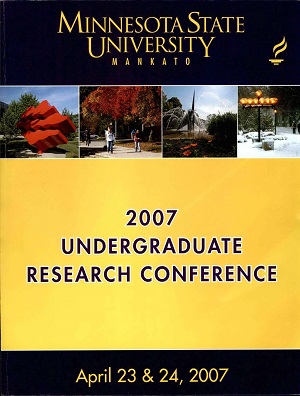Imminent Assimilation: A New Interpretation of Etruscan Cultural Material
Location
CSU 203
Start Date
23-4-2007 8:15 AM
End Date
23-4-2007 9:45 AM
Student's Major
Art
Student's College
Arts and Humanities
Mentor's Name
Alisa Eimen
Mentor's Department
Art
Mentor's College
Arts and Humanities
Description
Anthropologists and historians posit that cultural material can be used as a tool to measure geo-political stress on civilizations. I apply this theory to an ancient Italian culture known as the Etruscans (9th century BC to 1st century BC). Study of artistic production during years of increasing Roman contact makes it possible to identify common themes in Etruscan art, which symbolize the social concerns of a waning culture. Analysis of the effects of geo-political stress on artistic representation can determine to what extent an existing artistic practice assimilates ideas and motifs of a colonial power. In particular, this project determines the degree to which Etruscan art reflects social and political changes prior to its cultural decline engendered by increasing Roman dominance. By identifying the motifs used in artistic production during periods of historical conflict, it is possible to pinpoint socio-political events that likely affected artistic choices in subject matter. Using the Etruscan objects collected at Chicago's Field Museum, I conducted a thorough investigation to determine if Etruscan artists employed specific imagery to express changes in regional autonomy. Placing the museum's collection into this geo-political context provides a new perspective, emphasizing intrinsic artistic reaction to external pressures. By isolating objects that display concepts related to cultural identity, I reconsider the rate of Roman assimilation (260 BC to 88 BC). This new approach to Etruscan research contributes to a broader sociological understanding of cultural assimilation and its effect on material production. This method contrasts with conventional art-historical scholarship, which generally favors Greco-Roman culture. The existence of an artistic record of assimilation that focuses on the Etruscans and documents an increasing shift in imagery confirms a social awareness of imminent assimilation. In addition it suggests another method of art-historical research, confirming that cultural material is a viable tool in identifying geo-political stress on ancient civilizations.
Imminent Assimilation: A New Interpretation of Etruscan Cultural Material
CSU 203
Anthropologists and historians posit that cultural material can be used as a tool to measure geo-political stress on civilizations. I apply this theory to an ancient Italian culture known as the Etruscans (9th century BC to 1st century BC). Study of artistic production during years of increasing Roman contact makes it possible to identify common themes in Etruscan art, which symbolize the social concerns of a waning culture. Analysis of the effects of geo-political stress on artistic representation can determine to what extent an existing artistic practice assimilates ideas and motifs of a colonial power. In particular, this project determines the degree to which Etruscan art reflects social and political changes prior to its cultural decline engendered by increasing Roman dominance. By identifying the motifs used in artistic production during periods of historical conflict, it is possible to pinpoint socio-political events that likely affected artistic choices in subject matter. Using the Etruscan objects collected at Chicago's Field Museum, I conducted a thorough investigation to determine if Etruscan artists employed specific imagery to express changes in regional autonomy. Placing the museum's collection into this geo-political context provides a new perspective, emphasizing intrinsic artistic reaction to external pressures. By isolating objects that display concepts related to cultural identity, I reconsider the rate of Roman assimilation (260 BC to 88 BC). This new approach to Etruscan research contributes to a broader sociological understanding of cultural assimilation and its effect on material production. This method contrasts with conventional art-historical scholarship, which generally favors Greco-Roman culture. The existence of an artistic record of assimilation that focuses on the Etruscans and documents an increasing shift in imagery confirms a social awareness of imminent assimilation. In addition it suggests another method of art-historical research, confirming that cultural material is a viable tool in identifying geo-political stress on ancient civilizations.
Recommended Citation
Mayer, Lisa M.. "Imminent Assimilation: A New Interpretation of Etruscan Cultural Material." Undergraduate Research Symposium, Mankato, MN, April 23, 2007.
https://cornerstone.lib.mnsu.edu/urs/2007/oral-session-02/1




